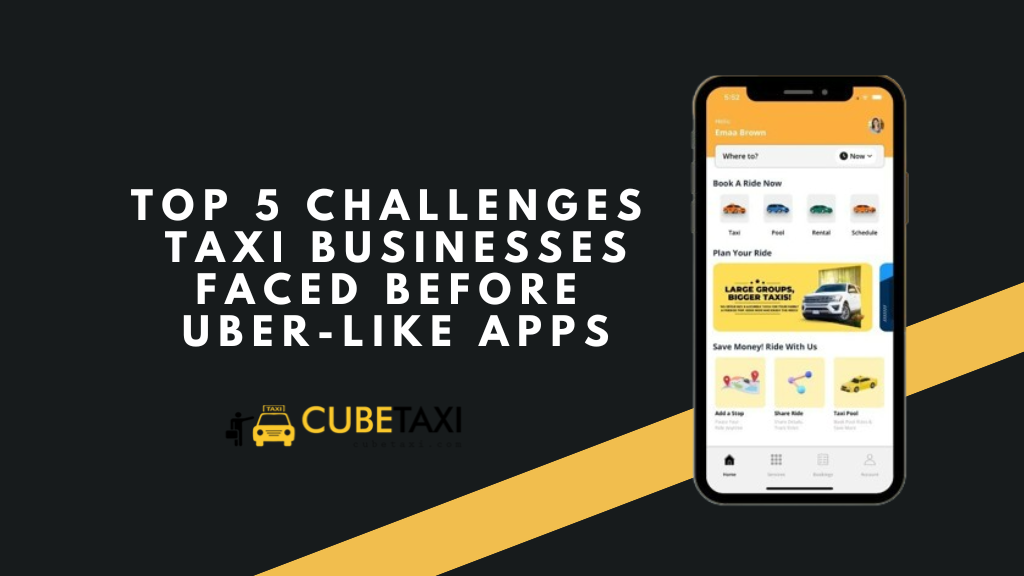Taxis have long been the staple of transportation systems in every part of the world. Undoubtedly, taxis offer people the most convenient way to get around town, taxis. However, because of technological advancements in recent years and the emergence of online taxi apps like Uber, Lyft, and Gojek, traditional taxi businesses have faded. On-demand taxi apps pose a set of challenges for traditional businesses. With innovative business models, taxi apps have already given direct competition to conventional businesses, lowering their chances of survival in the market.
But, that’s another story altogether. In this blog, let’s explore the five challenges that these traditional taxi businesses faced before on-demand apps like Uber arrived.
So, without further ado, let’s explore these challenges.
Challenge #1: No Convenient Booking System
Table of Contents
In the past, finding and booking rides was a tedious task. One would have to call the taxi service providers in their area to book a taxi.
On the flip side, if customers wanted to make changes to their reservation, they’d either have to call the providers or do it on the website.
However, with the introduction of Uber-like taxi apps, people can easily book rides, schedule them, rent cabs of their choice, and even opt for shared rides as well.
All of these services can be booked and managed right at the fingertips, thanks to smartphones!
Challenge #2: It was difficult to track Taxis and Drivers
Without taxi apps, it was difficult to track taxis and their drivers. The business owners would not know where the drivers are and at times, they’d get late for the pre-booked rides too.
This eventually negatively impacted the business and annoyed customers as well. However, because of the mobile applications, it is not easy to locate the taxis.
Even the customers can see the live location of their taxi driver on the map and also see the estimated time of arrival of the cab.
On the other hand, seamless GPS systems help taxi drivers to easily navigate to the rider’s location, saving their time and fuel!
Challenge #3: Limited Payment Options
Traditional taxi businesses have another greatest challenge – limited payment options. Yes, you hear it. In the past, customers only had the option to either pay in cash or via their debit/credit cards via the websites.
It was rather a limitation for both the business and the customers.
On-demand Uber-like taxi apps revolutionized payment systems. Using the app, people can now pay for taxi rides via their in-app wallets, credit cards, and also cash.
One-touch online payment methods make it even more convenient for riders to book taxis.
Challenge #4: Difficulty Finding Business due to Location Restrictions
Traditional taxi businesses were restricted to physical offices in a region. There were limited branches of the business where people could reach and book the taxis they wanted.
This meant that they had only a limited reach and only a few customers knew about the services they offer. In short, it was difficult for taxi businesses to find customers and boost sales.
But, with the introduction of mobile applications, things changed!
Now, taxi businesses can reach anywhere and everywhere, thanks to mobile applications. Uber-like taxi apps have bridged the gap between local drivers and customers. With a single tap on the screen, customers can send ride requests and get around the city in no time.
Location-related barriers have been eliminated. Moreover, this advantage has made it possible for businesses to expand their operations to various cities with a big pool of potential customers.
Challenge #5: Poor Customer Service
Back then, traditional taxi businesses either worked through websites or completely on manual bookings.
Because of the lack of automation processes, taxi businesses struggled to offer their customers top-notch customer service.
With the introduction of on-demand taxi apps, this no challenge was no longer a concern for businesses.
This was a major challenge for these businesses, as customers were often dissatisfied with the service they received. But, now, using mobile applications, taxi businesses can offer their customers:
- 24/7 support
- Option for in-app calling/messaging
- Gender-based driver preference
- Handicap Accessibility
- Instant notifications through push notifications
- Animated direction path to know where the current position of the taxi
- Add destination later option
- Rating & review section
In simpler words, 100% customer satisfaction!
In Conclusion:
Mentioned are only a handful of challenges that traditional taxi businesses faced before the introduction of on-demand apps like Uber.
Online taxi booking apps have revolutionized the industry, making it easier and more efficient for both customers and businesses.
Today, entrepreneurs from even the smallest cities are motivated to launch their own taxi apps and make money.
So, if you want to launch one, start looking for Uber Clone Script! Launch a fully-fledged and tested taxi booking app without splurging all your money.
